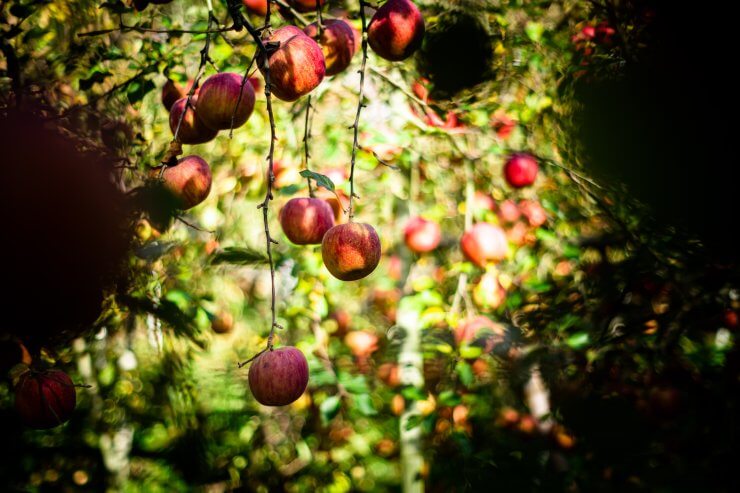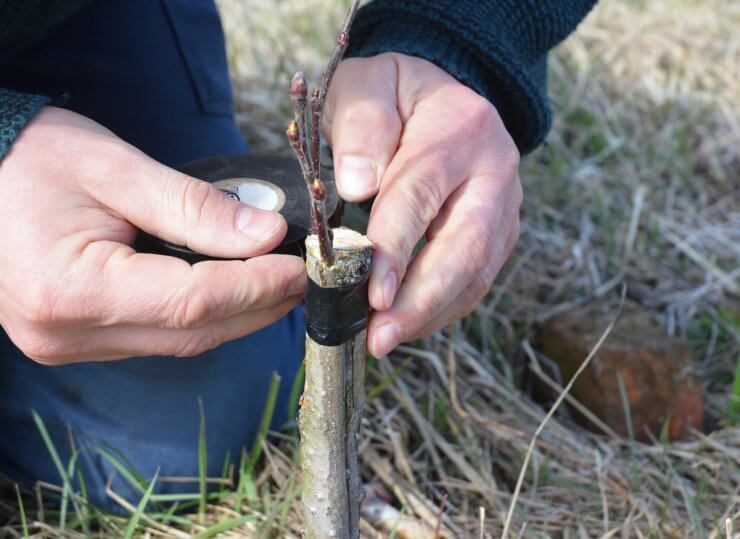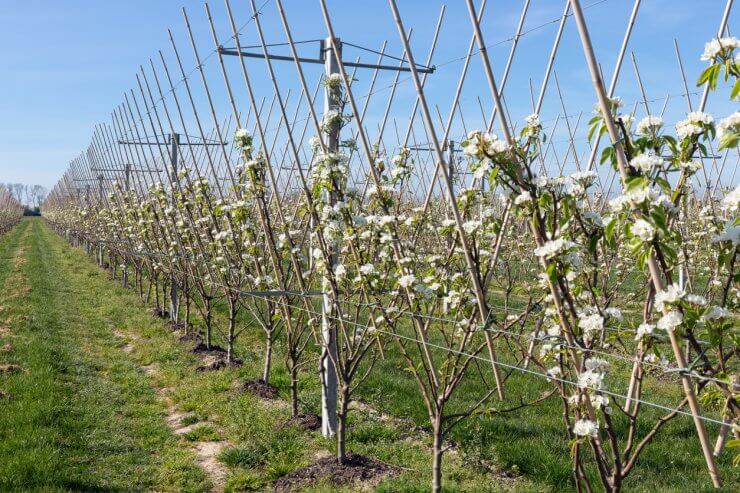
When I hear the word “clone” I either think of Dolly the sheep or binge-watching Battlestar Gallactica. But cloning fruit trees is neither of those things and it shouldn’t be feared. In fact, farmers and gardeners have been cloning fruit trees for centuries as an easy way to jumpstart a fruit tree’s life. Sure, you can try to grow a fruit tree from seed, but after they germinate, the seedling will likely be disappointing in comparison to the parent tree. Pollination is another factor that makes growing a fruit tree from seed tricky, especially if you don’t have the right trees and insects nearby to help pollinate. And then there’s the time consideration. An apple tree, for example, will take 7-10 years to grow from seed before you can even tell if it will bear fruit. I love a backyard orchard, but I’d like to enjoy it during my lifetime if possible!
Cloning fruit trees is a perfect solution for expanding your orchard in a shorter amount of time than if you were to grow fruit trees from seed. It is also very cost-effective. It oftentimes costs nothing, if you already have some basic gardening materials. So where to begin? Here are seven tips for cloning fruit trees to expand your orchard and brush up on your science skills!
Explore the easiest fruit to grow at home—indoors or out! Read our FREEBIE 15 Easiest Fruits to Grow at Home, right now!
1. Springtime is the best time
Though cloning fruit trees is possible year-round, you’ll find better success if you stick with the spring season. New growth on fruit trees will have softwood which tends to work best when cloning fruit trees. Look for vibrant green branches and new leaves. While you can attempt to clone fruit trees in summer and even winter, there’s more work involved in keeping the environment just right and it takes more time for roots to grow. Cloning fruit trees in winter can take up to six months just to root.

2. Using the cutting method
The cutting method is the more traditional way of cloning fruit trees which involves taking a cutting of new growth, dipping it in root growth hormone, and placing it in a growing medium until it roots. This method can be hit-or-miss with fruit trees and really depends on the individual tree type and season.

3. Using the air-layering method
Another method for cloning fruit trees uses the air-layering method. This is particularly useful with citrus trees and avocados, though nearly every type of fruit tree can use this method (Except bananas!) The air-layering method involves a bit of surgery where a small notch is made in a new growth stem of an existing fruit tree. After applying root growth hormone, the notch is wrapped in a moist root medium like coconut coir or sphagnum moss and wrapped in plastic. Once roots grow, the branch is cut below the new roots and transferred into an individual pot.

4. Using the grafting method
The grafting method is the gold standard for cloning fruit trees like apple trees and stone fruit trees (cherries, plums, peaches, nectarines). The grafting method involves a bit more tree surgery and connects a scion, or young tree cutting to a rootstock or trunk stock from an older tree. The rootstock should be a similar tree but doesn’t have to be the exact variety. The rootstock and scion are cut and fused together with tape and will grow as one tree.

5. Use clean instruments
No matter which propagation method you use, it’s important to use sterilized cutting tools to prevent the spread of disease and fungus. Isopropyl alcohol is by far the easiest way to quickly sterilize your tools and it evaporates quickly enough so you can get right to the task at hand. I like to use it fully concentrated, in a spray bottle. Just be sure to keep it out of the sunlight because it will evaporate quickly.

6. Visit your local orchard or nursery
My strongest recommendation is to visit your local orchard or nursery and talk to the experts. Get their recommendations and hot tips about cloning fruit trees. If you’re lucky, they might even give you a demonstration.

7. Record your process
This step is a bit nerdy, but it’s worth it! Any time you are experimenting in the garden whether it’s propagating trees or designing a DIY irrigation system, jot down what you did in a notebook. I can’t tell you the number of times I’ve gone out to check the progress of a tree or vegetable plant and find myself scratching my head trying to remember when I planted it and what type of fertilizer I used. Because cloning fruit trees is a bit more complex, write down the different variables you’ve tried. Record the dates of your activities so you can track the progress. This will be so helpful when you go to replicate (no pun intended) your tree cloning experiment in the future.
Cloning fruit trees may seem complicated but with a little trial and error, you can expand your orchard and enjoy the fruits of your labor. (Pun very much intended.) Once you’ve tackled cloning fruit trees, check out my experience with planting a bare root apple tree.
Have you tried cloning fruit trees? What works best for you? Let me know in the comments!
Explore the easiest fruit to grow at home—indoors or out! Read our FREEBIE 15 Easiest Fruits to Grow at Home, right now!





Can you clone them hydroponically?
How van you verify if a cultivar is patented?
I have a mulberry tree that I would like to propagate/clone, what would be the best way to do this?
Mulberry trees can be propagated by cuttings, grafting or air layering. Here’s an interesting article about the subject, including success rates and challenges of each method.
https://www.twisted-tree.net/propagating-mulberry-trees
How long does it take with air-layering for roots to appear?
Thank you in advance for answering.
Elaine
You should see results in approximately 3 months.
Hello,
When propagating or cloning any plant make sure that the plant is not patented. You cannot propagate patented or trademarked plant material, even for you own use. It’s not practical to propagate most fruit trees by cuttings and it is in my opinion in the long run not worth the time and effort. Many fruit cultivars or varieties do poorly on their own roots. That is why their grafted. Also many cultivars may be difficult to root. Small fruit like blueberries, raspberries, grapes which have non patented varieties may be easier to root, but apple, cherry, peaches, etc may be harder to root and survive on its own roots.
In a nutshell, best to put out the cash and start with nice tree from a reputable source.
I figure anything growing on my land is MINE to do with what I please. Patents on a fruit tree, I know you’re correct, but gimme a break. As long as I don’t take it to market what’s the harm? I’m guessing you don’t have a problem with Monsanto.
Can I use the base of an Italian Prune tree for the base of a peach clone?
Can I use the suckers at the base of a tree to clone?
Yes…but be sure the suckers come from ABOVE the graft line at the base of the tree, otherwise, you will be cloning the root stock, not the desired tree on the top. 😉
For example, many citrus trees have trifoliate orange as their root stock. You can recognize it by its distinctive 3-point leave (where the “tri-foliate” is from). Don’t clone that, the fruit is bitter and seedy, but it is very hardy and somewhat cold and virus resistant, so it makes a great root stock!